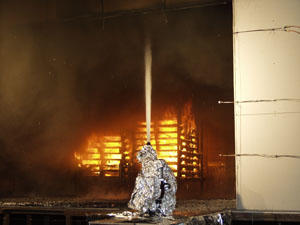Hose Streams
|


Preliminary experiments examining the distribution of different hose streams. |
Little, if any, fire suppression research has been conducted on the effectiveness of fire streams from manual hose lines during the past 50 years. Determining the effectiveness of a range of water application methods could have impact on the tactical decisions, equipment choices and water supply requirements that affect fire departments across the country.
This project examines a variety of fire fighting hose stream characteristics related to flow, distribution and thermal impact from both solid and fog stream nozzles. A series of real scale, laboratory based experiments have been started to look specifically at the water discharge and distribution characteristics, the impact of hose streams on a hot gas layer in a compartment, the impact of hose streams on gas flows through multi-compartment structures, and the suppression effectiveness on burning piles of wooden pallets. Based on data collected from these experiments, empirical FDS input sets for a solid stream and a narrow fog will be developed in order to re-create the results of the experiments. The final phase of the project will be to conduct a set of real scale validation fire experiments.
The spray measurements and data obtained from the previous full scale fire test series have been used to create a first-order hose stream model for implementation in FDS. The model is currently being refined with data from the following experiments:
|


Preliminary experiments examining the impact of different hose streams on a pallet fire. |
- Characterize the hose streams in terms of nozzle pressure, flow rate, area of influence and water distribution.
- Measure the ability of the hose streams to reduce the heat release rate of wood pallet fires burning in the open with no "compartmentation effects".
- Measure the ability of the hose streams to reduce the temperature of a hot gas layer in a compartment.
- Measure the ability of the hose streams to reduce the heat release rate of the wood pallet fires burning in a compartment.
- Measure the ability of the hose streams to impact ventilation and movement of fire gases in a multi-compartment structure.
Once the data from the above experiments is integrated into the hose stream models, the ability of FDS to predict the impacts of the water delivered by hose streams on the full fire environment will be examined in order to determine the capabilities and limitations of the hose stream models.
The final result from this research will provide a "manual hose line" suppression capability in FDS enabling the results to be used as a portion of a computer based training tool for firefighters. In addition, engineering predictions can be developed for hose streams and other manual water application techniques to provide guidance in the design and use of these fire fighting tools.
REPORTS
Introduction, Chapter 1: Fire Fighting Properties
VIDEOS
These videos are two examples of the preliminary tests performed on the effects of different types of fire attack strategies.

